As you have seen from this account so far, blood is a miraculous solution that could not have come into being by chance, and is one of the manifest proofs of creation. Here it will be useful to recall that though blood is a miracle, its existence by itself is of little significance, because in order for it to provide any benefits to a living organism, it also needs a transport system. That is provided by the circulatory network in the human body.
Blood also needs to be propelled through the veins and arteries to reach every cell of the body. The engine that provides that service is, of course, the heart.
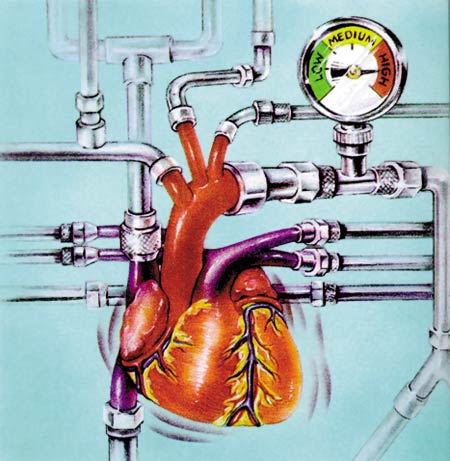 |
An indefatigable pump in your body works nonstop, 24 hours a day. In order to meet the body’s needs, this pump works using its own electrical system, requiring it to produce enough energy in an hour to lift an average-size car about 1 meter (3.2 feet) off the ground. That extraordinary pump is your own heart. |
The world’s most perfect pump is at this very moment right in your chest. With its unbelievable creation and incessant beating, the heart sends all your blood around your body some 1,000 times during the course of a single day.
The human heart is approximately the size of a fist, and is a pump made of muscle. Considered in terms of capacity, however, it is the most powerful, longest lived and most productive machine in the world. First off, its strength is quite magnificent: The heart can squirt blood to a distance of up to 3 meters (10 feet), and in the space of one hour, can expend enough force to raise a medium-sized car three feet off the ground.16
However, the heart’s most important feature is being able to work without stopping, contracting some 70 times a minute, and 37 million times a year. It beats some 2.5 billion times during the average human lifespan and pumps approximately 300 million liters (or 80 million gallons) of blood.17 That is the equivalent of the amount of liquid it would take to fill 10,000 oil tankers. Even while you sleep, your heart pumps some 340 liters (90 gallons) of blood. To put it another way, your heart could fill a car’s gas tank 9 times over every hour. During physical activity—while running, for example—its work rate increases and it pumps some 2,273 liters (0.6 gallons) of blood.18
Every time it beats, the heart sends blood into the depths of the body with great force. To get a better idea of this muscle’s strength, see how often you can fully clench your fist at a rate of once every a second. You will soon become tired and be unable to continue. After a few minutes, the muscles that move your fingers and hand will begin to ache. Yet your heart continues to expand and contract for your entire lifetime, and never rests for even a minute.
Another feature of the heart is how it pumps the required amount of blood according to prevailing conditions. Under normal circumstances—at rest—it beats some 70 times a minute. During exercise, however, the muscles need increased quantities of oxygen. The heart then increases the amount of blood it pumps, by beating up to 180 times a minute. It can increase the volume of blood it pumps by up to 5 times. A machine that works non-stop at that rate will soon break down, but the heart continues working this way for decades, never losing its rhythm.
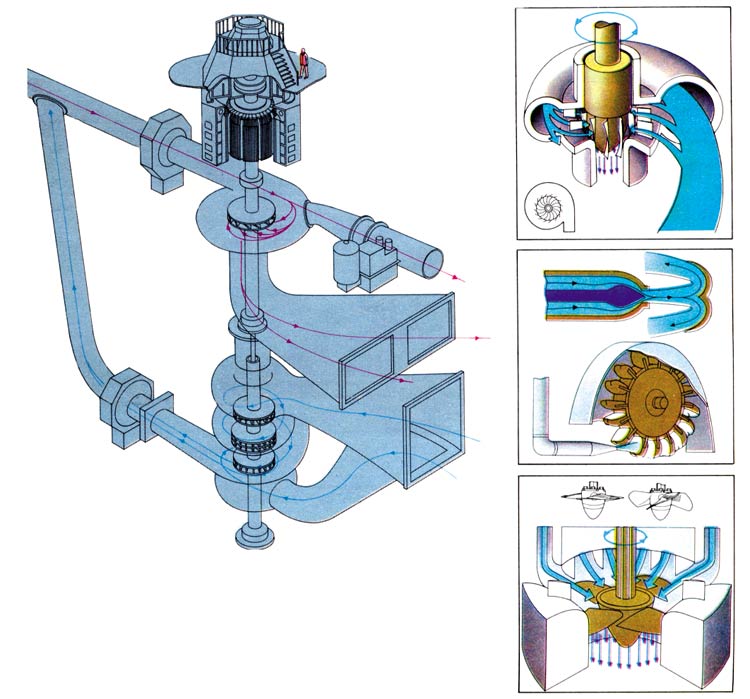 |
Blood cells moving in the veins |
To better understand the work performed by the heart, compare it to an artificial pump.
But the heart is not a simple pump that sends one liquid from one site to another. Its very special creation allows it to pump two different liquids in two different directions. Unlike most normal pumps, it has more than one speed and by itself, regulates the speed at which it needs to work in the light of prevailing conditions. Bearing these features in mind, we can compare the heart to a specially created pump controlled by a highly advanced computer.
A pump consists of an engine that provides power and the mechanical parts that the engine causes to function. The heart, on the other hand, is both a motor and a pump.
Man-made pumps last no longer than 10 to 15 years. During that span of time, the pump does work constantly, but only at specific intervals. Pumps that work all the time wear out after very short periods. In either case, the pumps sometimes develop faults and need maintenance or to have parts replaced. In contrast, the heart works 24 hours a day for as much as 70 or 80 years, or even longer. A healthy heart never requires any maintenance during that entire time. Unlike man-made pumps, it never needs to be repaired nor to have parts replaced.
 | |
1. The external membrane of the heart. | 11- The left ventricle, |
The heart starts beating while a human is still a fetus in the womb, and continues beating for a whole lifetime. The heart pumps blood at every moment of your life, without our being constantly aware of it and quite beyond your control. This pump was working while you were still a baby, and while you were at school, and continues working while you sleep. It is even working now, pumping blood even as you read these words.
When the general structure of the heart is examined in greater detail, you can immediately see its exceptional creation.
The heart is actually a combination consisting of two separate pumps. The one on the left pumps oxygenated blood to the organs and tissues in the body, while the one on the right pumps CO2 -laden blood to the lungs.
Each pump also consist of two separate upper and lower pumps. The smaller is known as the atrium, and the larger as the ventricle. When clean blood reaches the left part of the heart, for example, it flows into the upper small atrium. From there, it is expelled in to the larger ventricle below. The ventricle, or large pump, then sends the blood to the organs. The same process is also performed by the pumps on the right side of the heart, in sending blood to the lungs.
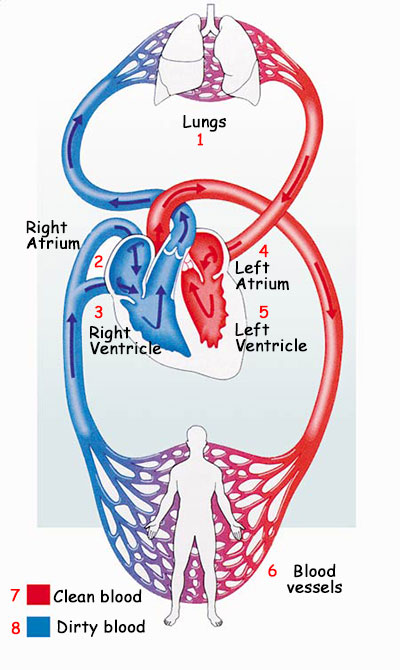 | 1. Lungs | 5. Left Ventricle |
Left | ||
The contraction of the atria and ventricles takes place in the exact opposite manner. In the working of the heart, details such as these are some of the proofs that this organ was created by a superior Intelligence. | ||
Bottom | ||
1. Aort | 4. Left Atrium | |
By contracting and expanding, the heart causes blood to flow through the body. As a result of the contraction of the atria and the opening of the valves in them, blood passes to the ventricles, and—as the ventricles contrac—from there to the arteries. The blood in the right atrium, returning from the body, contains less oxygen. The left atrium is full of oxygenated blood from the lungs. | ||
 | ||
 | |
A. The half-moonshaped valvelets. | B. Arteries |
1) The blood entering the ventricles pushes open the half-moon-shaped valvelets. | |
Between these pumps are valves that open only in the direction of the flow of the blood. When the atria contract, these valves are opened and the blood fills the large ventricles. When the large ventricles contract, the valves between close and the blood is prevented from flowing back to the atria from whence it came.
There are similar valves in the discharge part of the large pump. When the large pump contracts, these valves open, and the blood is allowed to flow out to the body.
When the beat is finished, however, the valves close to prevent the pumped blood from flowing back to the heart. This is a simple but most reliable precaution, and modern artificial pumps use similar systems.
The existence of just one of these valves is proof that the heart has been specially, consciously created. Leaving aside the heart’s hundreds of miraculous features, and considering only how its valves came into existence reveals to us Allah’s flawless creation.
No series of random events could ever create one of the valves in the chambers of the heart, let alone the flawless structure of the heart itself. Every detail of this perfect engine in the human body is proof of the might, power and existence of Allah.
They do not measure Allah with His true measure. Allah is All-Strong, Almighty. (Surat al-Hajj:74)
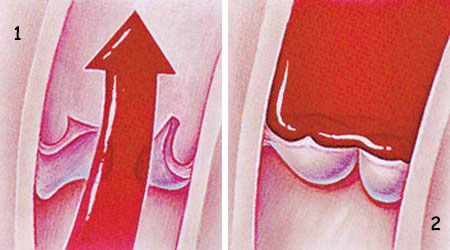 | 1. Valvelets open | 2. Valvelets closed |
1) As the veins contract and the pressure of the blood inside them rises, the blood is pushed upwards and allows the half-moon shaped valves to open. | ||
1. Trabeculae | 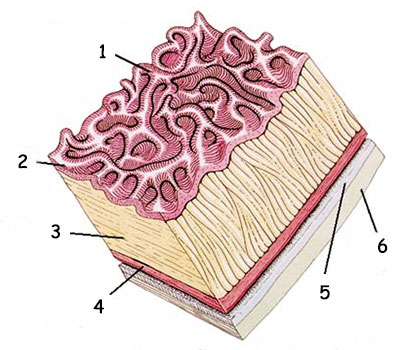 |
A cross-section of the heart wall. |
Consider the machines you are familiar with. Any machine, even a very simple mechanism, produces friction caused by the rubbing together of its components. Unless that friction is eliminated, the parts will soon wear out and the machine will be damaged enough to become inoperable. That means that its working parts need to be lubricated regularly.
The heart, which expands and contracts constantly for your whole lifetime, faces exactly the same risk. It needs a lubrication system in order to maintain its ceaseless functioning. On the outer layer of the heart lies a layer consisting of a two-layered membrane known as the pericardium. The space between these two membranes is filled with a special lubricating fluid— just one of the heart’s perfectly created details.
The body’s vitally important organs are protected in very different ways. The heart is one of the organs most in need of protection, since any blow to it could lead to lethal consequences. For that reason, your heart is located in the safest place—in your chest, inside the ribcage. The ribs protect the heart from blows from outside, just like the ribs of a ship’s hull.
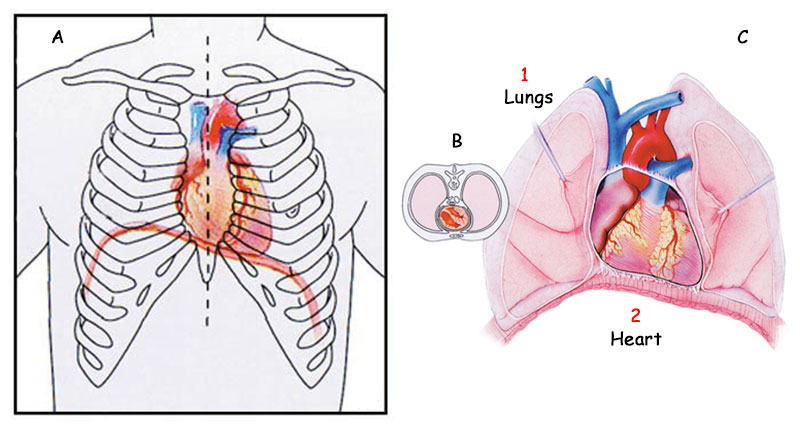 | |
1. Lungs | 2. Heart |
A) The heart’s links to the breastbone and ribs. | |
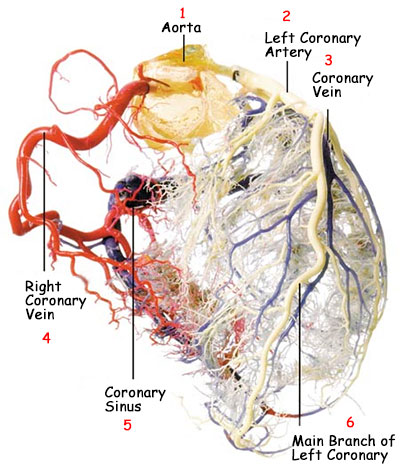 |
1. Aorta |
The veins and arteries that surround and nourish the heart. |
The tissues of the heart muscle are too thick and tight for nutrients and oxygen to pass through them, and are therefore unable to benefit from the blood pumping through it. However, like all other organs, the heart’s cells need blood. In fact, since it is a constantly functioning muscle, the heart needs even more oxygen than any other organ.
This need has, once again, been resolved thanks to a most incomparable creation. The blood arriving from the lungs to the left part of the heart is the cleanest, most oxygen-rich in the body. Two specialized arteries, known as the coronary arteries, emerge from the aortic arteries by which the blood is pumped out to the body. These arteries do not lead to the body, as do all the other arteries, but return to the heart. In this way, the most oxygen-rich blood is thus forwarded directly to the heart, without going anywhere else first.
Another feature can be perceived in the way the coronary arteries are laid out. As these arteries head towards the heart they make intermediate connections with one another, which connections serve as insurance against any one of the arteries becoming blocked. If one of the arteries does suffer an occlusion, the blood courses on through the other artery, by-passes the blocked area and reaches the heart muscle. This same feature is employed by urban planners when laying out networks of water distribution. In order that the city should not be left without water in the event of a fault in one of the existing pipes, this age-old network system of the human heart is copied on a far wider scale.
Even these connections made between the arteries nourishing the heart exhibit such reason and planning as to leave chance as no explanation.
Before moving on to other structural features of the heart, it will be useful to issue a reminder. Just bearing in mind the features described so far, you can see that the heart’s features could never have formed one by one, as evolutionists would have us believe—and furthermore, that all these stages could never have come into existence by chance.
In all regards, the heart exhibits a flawless and complete creation. It is impossible for this organ, or even any one of its components, to have come into existence by itself. In addition, even if we were to assume that such a perfect organ did emerge by itself—no matter how impossible that might be—it would still serve no purpose. Whatever ideal properties a heart might possess, in the absence of a circulatory system and blood to pump, it would have no bodily function. Again according to evolutionist logic, an organ with no function is doomed to become “vestigial” and disappear. But as you have seen, just one single example reveals the major contradictions in evolutionists’ claims.
If you extract a living heart from the body, it will continue working independently until it has consumed the last of its energy. If provided with the necessary oxygenated blood, the heart will still beat for hours, even if all its nerve connections are severed.
In order to examine this interesting situation, let us briefly review how the muscles work: For a muscle to contract, it first needs a command from the brain or the spinal cord. That command is in reality an electrical signal forwarded by means of the nervous system. Since the heart’s structure is composed entirely of muscle tissue, then a heart that beats some 70 times a minute needs to be electrically stimulated that many times.
Then how can a heart still continue to beat for a while even if all its nerve connections are severed and it is removed from the body? This leads us to ask where these commands to contract come from?
When scientists investigated this question, they encountered something most surprising. In the heart, there is a generator that produces its own electricity—a generator made of flesh, itself one of the components of the very heart it supplies.
An artificial generator goes into action in the event of a cut in the external electrical supply, and continues producing electrical current to prevent machinery from shutting down or being damaged. The heart, one of the most crucial organs in the body, is also similarly protected in order to ensure it is never harmed in the event of any interruption to its energy supply. For the heart to stop even for a moment could lead to grave damage to the brain and the rest of the body, and could even have fatal consequences. The electrical system operating the heart must therefore work without ceasing.
Scientists investigating this electrical system made even more astonishing findings. The heart functions not only with a micro-generator, but also thanks to an assembly of interconnected, programmed and systematic electronic circuits. This electrical management system works together with a number of elements, from the kidneys to the brain, and from the arteries to the hormonal glands.
Of course, this flawless creation in the heart, discovered only very recently by scientists, has been working non-stop for millions of years. Without exception, this system has been present in all the many billions of people who have ever lived, and in all those who will ever live in the future. This is Allah’s flawless creation.
When examined closely, the upper wall of the heart’s right atrium can be seen to contain this generator that supplies electricity to the heart. In an adult at rest, this generator, a knot of tissue known as the sinoatrial (SA) node, emits 72 low-frequency electrical impulses a minute.19 Each of these impulses causes the most perfect pump in the world to contract once.
To better witness the creation in this mechanism, let us now examine one heartbeat, which takes place in less than one second.
The energy wave emitted by the SA node spreads over the tissues that make up the heart’s small pumps (valves). Blood passes from the smaller atria to the large ventricles at the bottom of the heart.
Under normal conditions, however, one would expect the situation to be very different. The energy given off by the SA node, or generator will first stimulate the large pumps. Yet since the electrical wave moves very fast, both pumps will contract at almost the same moment and the heart’s working mechanism should be impaired. Yet such an electrical circuit must be constructed that the electrical energy must first stimulate the small atria, after which it must pause for an instant before stimulating the large ventricles. After the electrical signal has been emitted, it must pause until the small atria have performed their function. The necessary circuit needs to be a marvel of engineering.
In fact, after stimulating the atria, the electrical wave emitted by the generator moves to another tissue mass known as the atrioventricular (AV) node. This tissue holds onto the electrical signal for a very finely regulated interval of time, as short as 1/14th of a second. At the end of that period, the small atrium has finished its task. The electrical signal then continues on its way and stimulates all the ventricle cells in as little as 1/16th of a second. The larger pump, whose turn it now is, thus contracts and blood is pumped out to the body. All these processes take place in less than one second. 20
 | 1. Upper main veins |
The energy wave that causes the heart to work is initiated by the S.A. node in the atrium and with the help of the coronary artery, passes to the A.V. node, and from there to the right and left fibers. A special electrical system in the heart allows these processes to take place. The force that permits a piece of tissue to produce electricity belongs to Allah, Who has no partners in His creation. |
 |
When the main generator in the heart fails to work, the spare generator immediately goes into action. It is Allah Who created this protective system. |
The AV node, which halts the electrical waves emitted by the main generator for a short while, has another very important function. In the event of a problem in the main generator, this node steps in and works like a spare generator. It cannot produce signals as strong as those from the main generator (it produces only 40 to 50 signals a second), built they are still sufficient to let the heart keep working. If the main generator is damaged for any reason, the spare AV node undertakes an absolutely vital task. People have been observed to live for up to 20 years, even though their main generator has failed to function for various reasons. 21
To grasp what we have described so far, the reader needs a certain consciousness and understanding—which you, reading this book, do indeed possess. On close inspection, however, the components constituting the heart must also exhibit consciousness in order to function. For example, the reserve generator needs to be aware of everything that goes on in the human body in order to know when to assume its function, and needs to set the necessary system in motion in the event of any emergency.
Yet how do these components in the various parts of the heart carry out these processes, which we need to have awareness in order to understand? Can the nerve nodes in the heart be considered to have consciousness? Can it be claimed that these nodes calculate the seconds, and perform these calculations non-stop and always totally accurately? On their own, of course, these structures in the heart clearly cannot perform the complex processes necessary for the heart to function. These nodes are merely collections of cells that cannot be regarded as having decision-making mechanisms, will, or calculating ability.
Any cell being able to produce electricity is by itself a great miracle, because such production takes place as a result of thousands of very complex chemical processes. At this point, there are even more questions to be considered:
Why should a cell seek to assume the task of producing electricity? What force obliges it to do this? How does the cell know that the heart needs electrical signals in order to contract, and that the cells that bring about those contractions cannot function without electricity?
In addition, it is not sufficient for just one cell to produce electricity. It needs other cells producing electricity too, and these cells need to combine in the correct order. It is not enough for them to be present together. They must produce electricity together, as if they had signed an agreement to do so. Furthermore, that production needs to take place within a particular rhythm: Each cell has to possess a chronometer, and these cells need to accurately function once every 0.83 of a second. Additionally, the cells must be able to continue with this production tirelessly, for an entire lifetime. They must also know the level of electrical current that causes the heart to function, and must produce just the right amount of electricity—neither too much nor too little.
The untiring muscle cells in the heart must also possess a characteristic allowing them to function when the electrical current arrives. They must respond to every signal reaching them and respond to each one of the signals produced, 72 times every minute.
Since a specific understanding is required in order to grasp the functioning of this miraculous system, it would be irrational and unscientific to claim that it came into being through blind chance. Such a flawless system cannot be explained in terms of coincidences. The fact that such an electrical circuit has been placed inside the human heart is yet another proof that we have been created by Allah.
We created you, so why do you not confirm the truth? Have you thought about the sperm that you ejaculate? Is it you who create it or are We the Creator? We have decreed death for you and We will not be forestalled. (Surat al-Waqi‘a:57-60)
This section shall examine a very special system that regulates the working of the heart. We shall see how a piece of flesh immediately beneath the rib cage receives information, analyzes it and automatically carries out measures that need to be taken.
As a reminder, in examining the structures in the human body or in other living things, the most important thing is to ask whether they could have come into existence by chance. It’s of course impossible to pose this question with every description provided herein. But with this or any other book about the body, you should constantly ask yourself this vital question, because the answer will let you better appreciate the infinite might of your Creator.
Now, let’s examine the heart’s rhythm-controlling system, while keeping the above question.
The heart beats constantly to a regular rhythm. You can compare this to a car on a fixed-speed highway. Under certain conditions, however, the heart’s tempo needs to speed up or slow down. This is analogous pressure being applied to a car’s throttle or the brake pedal. The brake that decelerates the heart’s rhythm is the vagus nerve, and the accelerator that speeds it up is the sympathetic nerves. 22 The hormone acetylcholine sets the brake (or vagus nerve) into action.
The sympathetic nerves are components of the autonomous nervous system that work outside your free will and regulate the working of your internal organs. They raise blood pressure by narrowing the arteries and help form the hormones epinephrine and norepinephrine by stimulating the medulla region above the kidney. These hormones increase the heart’s work rate. The hormone thyroxin, secreted by the thyroid, also affects the working of the heart by raising the metabolism.23
So how do these accelerators work? How is the decision to speed up or decelerate taken? Such a regulatory and information exchange system has been constructed within the human body that no artificial information- processing network is nearly as perfect.
That this system functions within your body without your being aware of it, even at this very moment, is evidence that you were created.
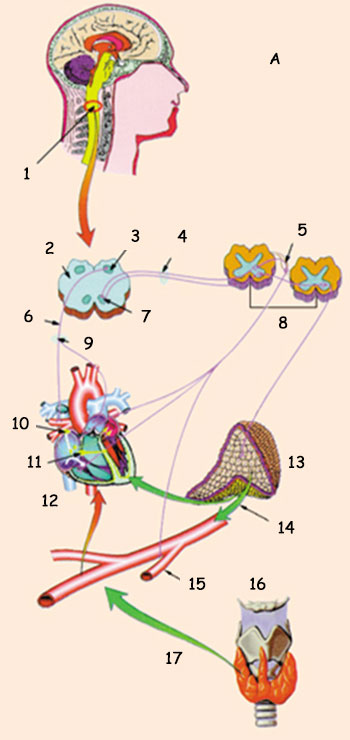 | A. Special tissues in the body regulate events during the heart’s contraction. 1. Center in the spinal bulb 2. Spinal bulb 6. Vagus nerve 9. Parasympathetic impulse 13. Adrenal gland 16. Thyroid gland |
The nervous system, the hormonal system and the organs attached to them - parts of the mechanism that regulates the heart’s functioning - all work together in great harmony. |
Let’s now examine how the controls in question are depressed, and how the decision to accelerate or decelerate is taken—while still asking the necessary questions.
When you perform a movement requiring force, the muscles around the veins accelerate the flow of de-oxygenated blood. This means that more blood goes to the heart and the right atrium. The atrium muscles then contract, and nerve signals formed as a result of that contraction are transmitted via the central nervous system to medulla in the spinal cord, which analyzes these data and immediately sends a command to the heart. The heart’s rhythm is accelerated. This allows more fresh blood to reach the muscles.
A key question: Is it rational and logical that this system could have come into being by chance? People who make such a claim are definitely unable to answer the following questions:
How are those receptors aware that de-oxygenated blood has increased and of the contraction created have been sited in the correct region of the heart, the right atrium where the dirty blood is found?
How did the network that carries the information from these receptors to the spinal cord and the medulla come into being?
How did the spinal cord and medulla—the data-processing center that analyses this data and is able to take the correct decisions—come into existence?
How does the medulla realize that the message reaching it signifies that oxygenated blood has decreased? With what consciousness does the spinal cord decide that the heart must beat faster in order to send more blood through the lungs?
How did the elements comprising this system come together as one and at the same time, exactly?
Such precise order cannot of course have come into being by chance. Not even a single component of this system—let alone the system itself—could have come into existence by happenstance. In addition to proving the invalidity of the theory of evolution, the above questions also clearly demonstrate Allah’s creation.
Let’s now examine another safety system created by Allah, and witness another proof of His creative artistry.
In addition, the heart needs a special safety mechanism to keep it from beating too fast and damaging itself. Inside the aortic artery emerging from the left-hand part of the heart are receptors that measure blood pressure. As the heartbeat rises, so does the pressure of blood reaching the aortic wall. When this pressure exceeds a certain level, the safety mechanism goes into operation. The receptors that detect the increasing pressure send warnings via the spinal cord to the medulla. This analyses the situation and sends a new command to the heart. This slows down the heart rate, and blood pressure is lowered. Let us now reconsider the pressure gauges inside the aorta and the heart’s braking mechanism.
Is it an unconscious coincidence that the heart is aware that too rapid a heartbeat will damage the body and that it should take measures to counteract this?
Did the receptors that measure blood pressure come into being by chance? And were these then located in the right place—in the aortic wall membrane—by also chance?
Did the nerve link between the receptors and the spinal cord come into existence by chance?
How do the receptor cells recognize that blood pressure has risen, and with what consciousness do they transmit news of this rise to the spinal column?
By what criteria does the medulla analyze the data reaching it? With what consciousness does it realize the importance of the situation?
How did some of the spinal cord’s cells come to assume the role of regulating the heartbeat? Why did they assume that responsibility?
How does a spinal cord cell decide to send a command to the heart? How does it know what form the command it sends must take, so that the heart cells can understand it?
Why do the heart cells obey signals from the spinal cord?
These questions are very important for lifting the curtain of familiarity that forms over the course of time and keeps people perceiving the miracles right before their very eyes.
Most people realize that some situations make their hearts beat faster. When you climb quickly up a staircase, run, or becomes excited, you can feel that your heartbeat has increased, and that later, it returns to normal. No one, however, realizes what a great miracle this truly is. They never understand that the rate of their heartbeat is regulated by a computer-like system inside the heart. Even if they are aware of the existence of a system, still they spend little time thinking about how their bodies’ miraculous systems came into existence, and even strongly avoid doing so. Some even believe that thinking too much about such matters is psychologically unhealthy.
The fact is, however, that Allah wishes us to think deeply. He commands people to ponder what He has created and thus, to better understand His might and power and to fear Him more. In one verse of the Qur’an Allah has revealed how believers should behave, how they should think about the entities created by Him—and how their fear of Him should increase as a result:
Those who remember Allah, standing, sitting and lying on their sides, and reflect on the creation of the heavens and the Earth: “Our Lord, You have not created this for nothing. Glory be to You! So safeguard us from the punishment of the Fire.” (Surah Al ‘Imran: 191)
16. Regina Avraham, The Circulatory System, The Encyclopedia of Health, p. 13.
17.Solomon, Berg, Martin, and Villee, Biology, Saunders College Publishing, USA, 1993, p. 890.
18.Marshall Cavendish, The Illustrated Encyclopedia of The Human Body, London: Michael Cavendish Books Limited, p. 70.
22.Curtis and Barnes, Invitation to Biology, New York: Worth Publishers, Inc., 1985, p. 415.
23.Vander, Sherman, and Luciano, Human Physiology: The Mechanisms of Body Function, New York: McGraw-Hill, 1990, pp. 255-279.